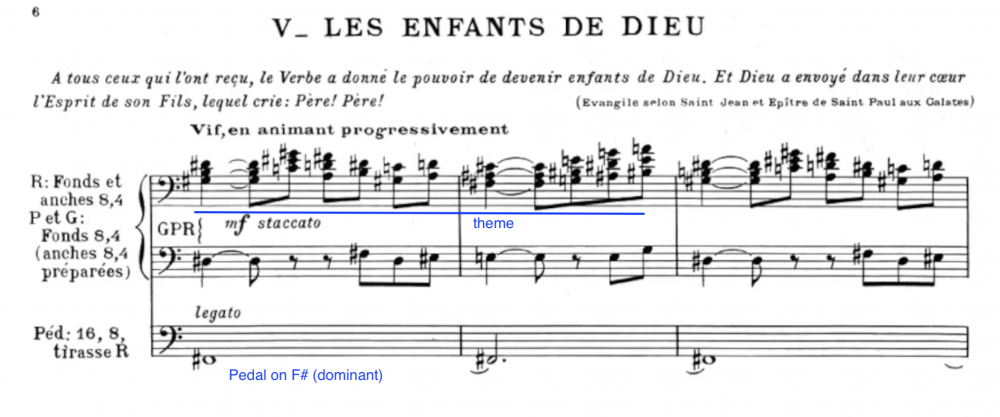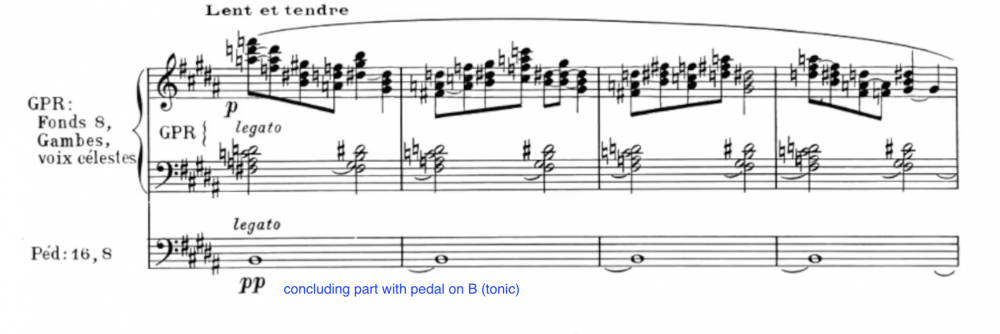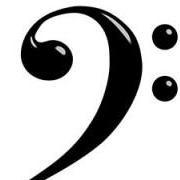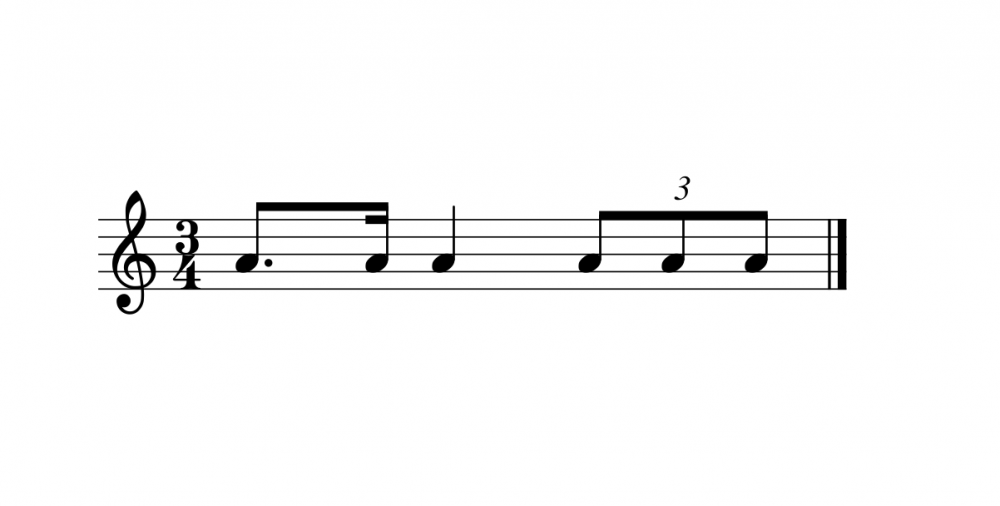Search the Community
Showing results for tags 'piano', 'sonata', 'solo' or 'alevel'.
-
Many classic forms were adapted in the 20th century. New ones were invented. Messiaen's musical world is amazing. Check what intervals are the best for him to build a cadence! Regarding the sonata, he says: "having written some absolutely regular sonata-allegros, we shall state that one thing in that form has become obsolete: the recapitulation. Then we shall try once more to keep what is most essential: the development. there are two in a sonata-allegro: the middle, modulating development; the terminal development, generally built over understood dominant and tonic pedals. We shall be able to write pieces made of this terminal development alone". And he gives this example from les Enfants de Dieu (from la Nativité du Seigneur): First element over a dominant pedal in B major and development A great fortissimo cry upon a sort of schema with augmentation of the theme A tender phrase, forming the conclusion, established over a tonic pedal in B major. You can hear this part here: In his writings, he gives additional examples of this kind of technique and new "free forms proceeding from the development of the sonata-allegro". Some thoughts about all this: Having in mind that tonality in Messiaen cannot be understood in strictly classic ways, he uses a contemporary technique (as Debussy did) to establish tonal centers and a relationship between them: the pedal tone. It's interesting how Messiaen is not interested at all in parts without development, ruling out at first glance the recapitulation ("obsolete") because it has no modulation nor development. It's also interesting how he takes only a section (or better said, the concept of a section) of the sonata-allegro, to build up his own coherent form. In my opinion, this is related to the big idea in Messiaen of "progressive music": non retrogradable rhythms or added values, non transposable modes... All of them have to be with that idea on not allowing the music to fall in the repetition patterns where classic music had rely on. This is just an example of what Messiaen did with forms. He talks about fugue, an other forms he was interested in, some of them fresh and new (Bird son), some old (plainchant). Is this concept interesting for you? For me, it is. It opens more possibilities of organising music material.
- 9 replies
-
- 1
-

-
- sonata form
- sonata-allegro
-
(and 2 more)
Tagged with:
-
Well, this is the recomposed version of a "minuet attempt" that I composed some time ago, I recomposed it just today. I recomposed it because the bass was very simple (just octaves in half notes), and it didnt have the form of a minuet. at least now it haves the form I include an harmonic analysis (very roughly) Almost all the minuet is based on the motive of the image The trio isn't finished, I will add it later Any comments are apreciated :3.
-
After a two-year hiatus, for the month of December I decided to go back working on this set of 26 minuets which I have been working on off from 2016 to 2017, and stopped in 2018 when I have other things to work on. Here's the status of the minuets as of April 2018: Anyway, after that and up till December, I have gained new musical knowledge and experiences which can be reflected in this new version of the set. More dynamics are added, the pitch range has also been expanded as well and incorporating other forms (Rondo and Sonata) into a few of the minuets as well. Many of the musical ideas for the minuets are taken from several sight-reading books, string quartets by Mozart and Haydn and other composition and theory workbooks. It has been quite a lot of fun finishing the set, exploring new musical ideas and many major/minor keys, and through this I have grown as a composer. I plan to move beyond the piano and work on a set of preludes and fugues for string quartet after this. I also hope to live record these minuets one day, especially the whole tone (XXV). Any suggestions on how to improve, or if you need to understand some of my thinking behind the minuets, you can say so in the comments. (I'm still working on a commentary by the way, but need to tell you that the last uses two different octatonic scales for the minuet and trio respectively.) For those who are not able to listen to the whole set, I suggest looking into these: II (A minor), IV (E minor), VI (E minor), VII (A major), IX (E major), XII (G sharp minor), XIII (F sharp/ G flat major), XIV (E flat minor), XVI (B flat minor), XIX (E flat major), XX (C minor), XXIII (F major), XXIV (D minor), XXV (Homage to Debussy), XXVI (Homage to Prokofiev).
-
Hello ! I'm sharing one of my compositon with you 🙂 I compose it last year when I had my exams. It was a very stressfull moment for me so I decide to compose 😛 Sheet music : apaisement_2 - Copie.pdf Hope you enjoy it 🙂 version_finale_apaisment 2.mp3 Julien Kaw
-
I always wanted to write something for violin because is one of my favorite instruments allong with guitar and piano, so I decided to write a preludio and allegro (that was some time ago). But when I showed it to one friend of mine who is a violinist, she said that more than a prelude it feels like and etude because of the very high notes in measures 12,13,28,29,56 and 57. So, i would like a second, third etc opinion about that. For all the violinist out there, are those notes that hard to play, and how is the prelude overall?. Thanks in advance for all the comments :3.
-
This is one of my longer works; just finished it today, so yay! I could really used some feedback for future versions, though. The formatting is also a little suspect, as are the harmonies, perhaps. I was going for an Impressionistic style. It is inspired by the journey of the Christian faith.
-
This piece doesn't really expand on the idea of the episode much more than the last one -instead, I develop more attention to the material within the overall structure. Sorry for the rendering, I think the sffz destroyed my speakers!!!
- 5 replies
-
- piano
- contrapuntal
-
(and 1 more)
Tagged with:
-
Composition completed on 06/04/2016 You also can watch this piece here -
- 2 replies
-
- etude-tableau
- piano
-
(and 3 more)
Tagged with:
-
-
Well, this is a rondo that I composed some time ago. I know the last measures are almost impossible to play, i will nerf them later. Any comment is apreciated :3..
-
Hello Guys ! First of all, HAPPY NEW YEAR !!! I'd like to share with you another of my composition which is " In Limbo " Hope you enjoy it 🙂 Julien Kaw limbes.mp3
-
In this piece, I've taken the ideas I had behind the formal structure of my earlier upload, Episode #1, and I've changed it up a bit (largely listening to the critiques that work garnered). I've never been good describing my ideas in detail -long standing trait. Much like Episode #1, this work takes the basic Rondo structure and expands upon it. When I originally thought of the idea for an episodic (rondo-like) formal structure, my original goal was to intersperse the A sections with heavily contrapuntal material (B, C, and D sections all being fugal in nature). While I still may do a work like this in the future, I think that -for now- I'm trying to find a way to make this type of structure work for the language that I use in my works. The score is a lot nicer (thank you MUSESCORE!)
-
Hi :3, I´m new to this forum. I'm a begginer composer I would like to have some feedback on my first piano sonata. Thanks in advance for the comments. I added an mp3 an here is a link to a youtube video with the sheet music. https://www.youtube.com/watch?v=ODoW8caLo0k Here is an analysis of the structure. 0:00 exposition 0:00 Introduction 0:26 first theme C minor 0:45 bridge 0:51 transition theme Eb minor 1:03 bridge 1:14 Second theme Eb major 1:29 Transition 1:37 retransition progression by circle of 5th 1:44 second theme Eb major 1:52 retransition to the first theme 1:59 repetition of the exposition 3:25 Development 4:13 dominant preparation 4:42 recapitulation 4:42 first theme C minor 5:02 bridge 5:09 transition theme C minor 5:32 second theme C minor 5:47 bridge F minor 6.02 second theme C minor 6:10 Coda C----------> Eb major-----> C minor
-
Prelude III: This prelude is more of a meditation, similar to prelude 1 -however, this is non-serial. The basis is the left hand arpeggiation pattern. Hope you enjoy! Prelude IV: This prelude, comprised of only 4 notes, is a theme and set of variations on the opening 2 bars. I tried to keep interest. Still tinkering with musescore -so some of the articulation marks at the ending are incomplete. I'll add those later. Hope you enjoy!
-
The beauty of music is that it brings people together. From all over the world! It’s an universal language to which we all can connect. A couple of months ago I met macky@piano♪♪(まっきぃ) She is a wonderful pianist from Japan playing outstanding improvisations. Music that speaks to the heart and mind. I'm a big fan of her and it is a great honour to do this collaboration with her. A sweet, romantic music track within the atmosphere of Christmas. On the piano: macky@piano♪♪(まっきぃ) Arrangement, mixing and mastering: David Jansen [a.k.a. Gh0stwrit3r] I hope you enjoy it!
- 4 replies
-
- piano
- orchestral
-
(and 2 more)
Tagged with:
-
Hey everyone ! I'd like to share with you my first composition which is " L'étoile " ( the star in french) I hope you enjoy it 🙂 See ya J.Kaw © Julien_Kaw version_finale_etoile.mp3
- 4 replies
-
- 1
-

-
- orchestra
- orchestral
-
(and 2 more)
Tagged with:
-
While working on this piano concerto, I have a lot of material that I'm leaving out -and have decided to use in smaller works (particularly for the purpose of keeping clarity in my material for the concerto). This work uses a tone row built upon intervals of the 4th. The opening bar, which creates a ritornello throughout the work, is the full row. Some notes about the compositional processes I used in this piece: 1. The form could be considered a rondo of sorts. The ritornello passage is labeled E. This returns after each 'episode' labelled C. I chose to keep this material identical. I may at a later date change the last entrance of the ritornello (mirroring it into the retrograde so that it ends on the note the piece begins). 2. The various episodes tinker with aspects of counterpoint (stretto, imitation, invertible counterpoint). The first episode superimposes rhythmic variants of the thematic material creating a rich texture. The second episode takes this type of superimposition and thins it out a little bit (leaving the superimposition to only two voices, while the remainder of the material is condensed into the chords seen in the left hand). NOTE: The second episode does NOT use the full tone row at all -at least not in order. The third episode plays around with invertible counterpoint and imitation, with a twist. The final episode -nearly devoid of counterpoint- is more intended on providing material to close out the piece. Hope you enjoy. I'll be cleaning up the score here in a few weeks once I get my new laptop set up!
-
I wanted to share this little piece composed by a friend of mine and me, two years ago, for Christmas. It was inspired by the facts taking place in World War I, when there was a spontaneous truce in Belgium. Each band (English and German) started to sing Silent Night in their own languages, the fighting was stopped, and they even shared gifts and hugs. The next day they buried the fallen soldiers... (Sorry, in the score it is explained in Spanish).
-
Hey all, I am working on a collection of small pieces, preferably 5, based on short stories (hence the name). I made a rough draft of the first one and was wondering if it was an idea worth continuing. Any comments would be helpful! (Just added multiphonics to the trumpet part, anyone know if the part is playable/ how it would sound in real life?) https://musescore.com/user/20408661/scores/5815887 Thank you!
-
Composition completed on: Etude-Tableau №8 in F sharp minor ICO №94 - 09/09/2016 Etude-Tableau №9 in F major ICO №95 - 09/11/2016 You also can watch this piece here -
- 2 replies
-
- 1
-

-
- etude-tableau
- piano
-
(and 3 more)
Tagged with:
-
Composition completed on 07/30/2016 You also can watch this piece here -
- 2 replies
-
- cyberpianist
- etude-tableau
-
(and 3 more)
Tagged with:
-
Composition completed on 05/10/2016 You also can watch this piece here -
- 2 replies
-
- etude-tableau
- piece
-
(and 2 more)
Tagged with:
-
Tried to improve on the old nocturne in Eb major. It was a real pain this one. Please let me know what you think and any feedback is good.
-
Hey Im writig a piano Concerto and have hit writers (Composers) block. i'm not convinced with the section at the end which would be the transition to my second subject. any advice welcome. ( i Know i haven't actually put the piano in the score.)
- 8 replies
-
- sonata form
- concerto
-
(and 1 more)
Tagged with:








